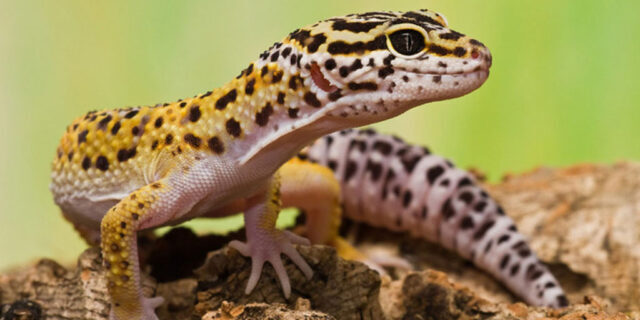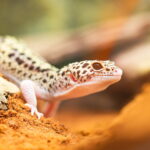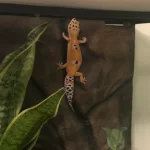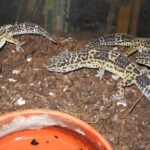As a beloved pet in many households, the Leopard gecko deserves attentive and caring owners. An integral part of proper Leopard gecko care is understanding what constitutes healthy and normal behaviour for these gentle lizards. By educating ourselves on normal Leopard gecko mannerisms, we can better provide for our scaly friend’s needs and ensure its wellbeing. In this article, we will cover various aspects of healthy Leopard gecko behaviour, including:
- Activity patterns
- Movement and exploring
- Eating habits
- Defecation
- Shedding routines
- Hydration and drinking
- Signs of sickness
Getting to know what is “normal” for a thriving Leopard gecko allows us to recognize potential problems early and address them. Let’s explore some key behavioral indicators that our Leopard gecko is happy and healthy.
Table of Contents
Daily Activity Cycles
As nocturnal creatures, Leopard geckos are most active in the evening and night. During daylight hours, they will likely be relatively inactive, preferring to lounge or sleep quietly in hides, burrows, or shaded areas of their habitat.
When the sun goes down, a healthy Leopard gecko will emerge to bask under heat lamps or warming pads. This signals the start of their day and they will begin puttering around their enclosure, peering into nooks and crannies, climbing on branches and decor items, and hunting for tasty insects or worm treats.
Normal Movement and Exploring
A well-adjusted Leopard gecko exhibits natural inquisitiveness and likes to deliberately explore its surroundings. Unafraid, it will purposefully walk and climb around at an unhurried pace, occasionally stopping to inspect objects more closely.
Watch for robust mobility and strong limbs as it traverses its habitat. Healthy front and back feet should appear straight, without twisting or curving. The tail should drag behind, not fall limply to one side.
Also expect occasional pauses as the gecko tastes the air with its tongue to pick up chemical cues. This is normal sensory behavior.
Eating Habits
These small lizards are built to be hunters and consumers of frequent small meals. A healthy Leopard gecko will readily pursue and eat live insects or commercial gut loaded feeders. Ensure its diet includes an appropriate ratio of insects to worms.
After capturing and subduing prey in its mouth, observe your lizard while it eats. It should be able to effectively bite down, chew, and swallow easily. Any difficulty grasping, biting, or manipulating food could indicate an underlying health issue.
Watch that the gecko eats with enthusiasm at regular intervals. Healthy Leopard geckos have a reliable appetite and will not ignore opportunities for an insect snack! A decrease in appetite can be an early warning sign of illness.
Defecation
Normal digestion requires regular bowel movements. Expect a healthy Leopard gecko to pass stool every one to three days. Look for brown and white uric acid components excreted together.
Frequent defecation in a particular “bathroom corner” of the habitat is common and not a concern. Just clean this area more frequently. Sudden loose stools, constipation, or bloody feces always warrant a veterinary visit to diagnose the cause.
Shedding Skin
In order to grow, Leopard geckos need to periodically shed their skin in sections or all at once. Skin turning whitish and opaque precedes a normal, healthy shed. Your gecko may also rub against objects to help loosen skin.
Never peel shedding skin! Allow the process to complete naturally over several hours or days. Retained skin can cut off blood supply to digits or appendages. After shedding, check your lizard’s coloration for any abnormal discoloration.
Hydration
While Leopard geckos gain moisture from prey, occasionally drinking water is still important for hydration. Ensure clean water in a shallow dish is always available, both day and night.
Although you may not observe your gecko drinking frequently, recognize its ability to find and lap water when needed. If increasing water dish visits occur suddenly, suspect dehydration or improper environmental temperatures.
Signs of Sickness
Catching signs of illness early allows for quicker veterinary treatment and better outcomes. Notice these abnormal behaviors that can indicate health problems:
- Lethargy and decreased activity
- Loss of appetite
- Weight loss
- Difficulty with coordination or limb weakness
- Heavy breathing through an open mouth
- Discharge from nostrils or eyes
- Skin color changes
- Lumps, swelling, or injuries
If any abnormal symptoms appear or persist beyond 24 hours, contact an exotic animal veterinarian, as antibiotics, fluids, or other supportive therapies may be needed. Keep records of symptoms and concerns to share with the vet.
In Conclusion
Caring, observant Leopard gecko owners have the reward of a healthy and thriving reptilian friend! By learning normal behavioral patterns and activity, keepers can provide proper habitat conditions for natural behaviors to occur. Monitoring any significant deviations from normal allows illness to be caught early when medical treatment has the best outcomes. Pay attention for positive signs like regular eating, moving, and defecation that show your beloved scaly pet is healthy and happy! I sincerely hope you find this “Healthy Leopard gecko behaviour” article helpful.





